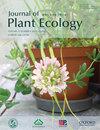青藏高原相同地理气候环境下的松毛虫草地盘状群落
IF 3.9
2区 环境科学与生态学
Q2 ECOLOGY
引用次数: 0
摘要
嵩草草地是青藏高原畜牧业的主要牧场,可能代表不同放牧强度的替代稳定状态。其他植物群落继承这些草地的能力尚不清楚。在本研究中,从土壤剖面的角度分析了植物群落的历史数据,并通过调查其植物群落来确定其目前的特征。确定了四种类型的稳定状态,对应于>11、8-11、5.5-8和<5.5羊/公顷的放牧强度。干旱的高山沼泽草甸和灌木草甸在过度放牧条件下可以接替皮格马草甸和胡麻草甸,其总生物量和可食生物量(以禾本科和莎草科估算)随着放牧强度的增加而减少。各州的制度转变发生在8–11只羊/公顷的放牧强度下。因此,该值代表了嵩草草甸演替过程中生产和生态服务功能发生显著变化的阈值。总的来说,放牧强度的增加会对草地的畜牧生产和生态系统稳定服务能力产生不利影响。本研究揭示了高山嵩草草甸潜在的退化演替过程以及退化草甸恢复过程中的演替方向。此外,本研究为评估稳定状态下的牲畜承载力和承载力之间的适应性提供了理论依据,并为可持续发展框架下的嵩草草地利用政策制定提供了学术参考。本文章由计算机程序翻译,如有差异,请以英文原文为准。
Kobresia pygmaea meadows as disclimax communities in the same geographic and climatic environments in Qinghai–Tibet Plateau, China
Kobresia meadows are the main pastures for animal husbandry on the Qinghai–Tibet Plateau, and may represent alternative steady states associated with different grazing intensities. The ability of other plant communities to succeed these meadows remains unclear. In this study, the historical data of plant communities were analyzed in terms of the soil profile, and the present characteristics were identified by investigating their plant communities. Four types of steady states were identified, corresponding to grazing intensities of >11, 8–11, 5.5–8, and < 5.5 sheep/ha. Drought alpine swamp meadows and shrub meadows could succeed to K. pygmaea meadows and K. humilis meadows under overgrazing, and their total biomass and edible biomass (estimated by Gramineae and Cyperaceae) decreased with increasing grazing intensity. The regime shift of the states occurred at a grazing intensity of 8–11 sheep/ha. This value thus represented the threshold of significant change in the production and ecological service function in the Kobresia meadow succession process. In general, increasing grazing intensities can adversely affect the service ability of meadows for livestock production and ecosystem stabilization. This study revealed the potential degraded succession process of the alpine Kobresia meadow and the succession direction in the restoration process of degraded meadows. Additionally, this study provided a theoretical basis for evaluating the fitness between the livestock bearing capacity and carrying capacity in steady states and academic reference for policy setting pertaining to the utilization of Kobresia meadows in a sustainable development framework.
求助全文
通过发布文献求助,成功后即可免费获取论文全文。
去求助
来源期刊

Journal of Plant Ecology
生物-植物科学
CiteScore
4.60
自引率
18.50%
发文量
134
审稿时长
3 months
期刊介绍:
Journal of Plant Ecology (JPE) serves as an important medium for ecologists to present research findings and discuss challenging issues in the broad field of plants and their interactions with biotic and abiotic environment. The JPE will cover all aspects of plant ecology, including plant ecophysiology, population ecology, community ecology, ecosystem ecology and landscape ecology as well as conservation ecology, evolutionary ecology, and theoretical ecology.
 求助内容:
求助内容: 应助结果提醒方式:
应助结果提醒方式:


